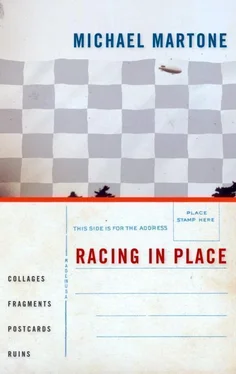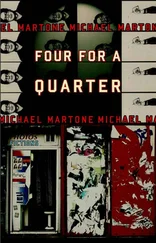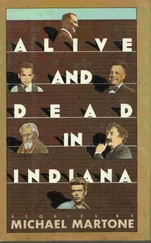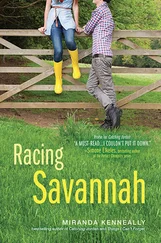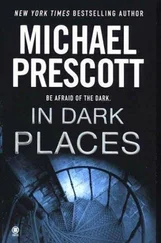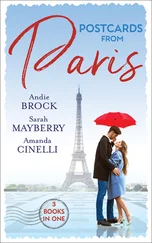14
In the literature of elevators (Coover, Dahl, Whitehead), there is the moment when the car keeps going up. It is an extension of the initial wonder. Gravity has been resisted. The sky can now be scraped. The apparatus is so simple, so transparent, a parlor suspended by a thread. It is a daydream of elevator travel. The dream has you traveling in an elevator, pushing the button for the top floor, but as the vehicle arrives it rises above that, breaks through the ceiling, the roof, and keeps going on, up and up. As with all travel, it is the journey and not the destination. The protocol of elevator travel demands a silence among its occupants. No time here in the flight between floors for the dissertations of train travel, the memoirs of an ocean voyage, or even the interviews of the air. We become the center of gravity. We talk to ourselves. We dream our dreams. We contemplate claustrophobia, acceleration, even death. You have your excuse, this booth. For many it is a routine routine, a daily affirmation. This is a mechanized meditation. This is a special species of stillness at the heart of our teaming urban hives. We enter. We arrange ourselves. We face the closing doors. We suspend our animation. We go up.
Still Life of Sidelines with Bob

The Game Away from the Ball
Basketball coach Bob Knight of the Texas Tech University Red Raiders is riding the referee. It is the opening seconds of the home game with Oklahoma University, and the ref lucky enough to pull the assignment to patrol the bench-side corridor from Texas Tech's back court to Oklahoma's base line is weathering the sniping coming from Knight, pacing parallel. After a few minutes of this criticism, the ref has developed a twitch. He is flinching, his head turning toward the coach then shying away. Every call, no matter who is calling it, is being questioned, commented on, underscored. The ref's attention is being divided. His reaction time dulled. Running up the court, he stalls sooner after crossing the timeline, adding a bit more distance from the glowering coach. He is being conditioned. He can't take his eyes off his own periphery now. And then, like that, Coach Knight lays off, slumps into his chair and assumes the position, his arms wrapped around his broad chest, his head down, brooding, Olympian, his dark eyes looking out from beneath his dark and darkening brows, intent on the game before him.
I have no idea what is going on in the game. I have been forcing myself to watch this drama on the sidelines, one of Coach Knight's calculated contributions to the flow and tenor of the remaining minutes of play. Roger Angell has pointed out that in baseball, the only game where the ball doesn't do the scoring, the spectator must widen the field of vision to the whole playing field. Basketball fans certainly know of the game away from the ball-the screens and constant cuts, the choreography of checks and switches, pickups and block-outs performed covertly while the player in possession dribbles into position or coils in anticipation of the perfect bounce pass to the now-open man. In spite of sensing the complete action of the court, that bouncing ball more than likely rivets the fan's attention, its trajectory through the air mesmerizes. That is why I have had to expend so much energy to ignore the attractive nuisance of that ball in its flight and the furious action swirling around it to focus on the nowstill center that is Coach Bob Knight.
In his thirty-five years of coaching college basketball, he has constantly shifted our attention to the game away from the ball. By that I don't mean simply the machinations of his players on the floor or even his psychological gamesmanship on the sidelines. It still matters that teams he coaches win, that the ball goes through his team's hoop more than the other team's. After thirty-five years in the presence of Bob Knight, however, the game away from the ball has expanded way beyond the game on the floor, in the arena, in the league, in the season. The game away from the ball has expanded to include institutions, state governments, whole peoples even. Our vision has shifted. We no longer keep our eye on the ball. Our eye is drawn to Knight.
Dazzleflage
Coach Knight, inert in his chair on the sidelines, wears a black pullover. Black is one half of Tech's colors. The other is scarlet, the shade of the collar of the golf shirt he has on beneath the black sweater.
There are a couple of things odd about this black. For one, it's not red, or more exactly, crimson, a color of Indiana University, where Coach Knight coached famously for twenty-nine seasons. The scarlet at his throat today is a tease, sharing some of the same frequency of that other red, but it is eclipsed by that ex pause of smothering black. This black, the black of his sweater, is matte, flat, a color drained of color, and it could stand for all that will not be spoken about the history of his years in Indiana and his departure from the university where he was, until recently, so closely identified. The media guide I got along with my souvenir basketball scrupulously records his statistics of victory, the irresistible climb to 800 wins, the three national championships, the Olympic gold medal, the histories and careers of the scholar-athletes he nurtured during those years. It also scrupulously deletes the acrimony of his firing from IU, the legacy of controversy, the public displays of anger, the accusations of bullying, the actual acts of violence. There is, then, this absence. The black is a hole at the core of the excitement about the commencement of this new winning tradition at Tech.
The color of the sweater itself not what I want it to symbolize, its black does seem to absorb light, to flatten the figure who wears it. It is a kind of camouflage. It is a countershading that is goofing with my ability to read, in folds of cloth and the way light falls on fabric, the distance and depth of an object. The object I'm looking at, Coach Knight, is collapsing, collapsing in on himself. As I stare at him, from my perch on the mezzanine, he is beginning to, well, disappear.
It's funny I should be thinking of camouflage, as this is the game where students, on their own initiative, have created a new T-shirt on sale for the first time in the arena's Double T shop. Rising behind the bench and Coach Knight, the stands emit the traditional broad swatches of black-and-scarlet-clad boosters arrayed in bands of color into which the coach is beginning to blend. Here and there among the solid blocks of color are veins of these new camouflage shirts. The usual smattering of forest camo browns and greens, the woodland splotches and smears, have been replaced on these tees by shades of scarlet, white, pink, and black. The shirts' jumpy patterns disrupt the ironed-on message. "The General's Army," it says, invoking Coach Knight's nickname. As the game goes on, the camouflage pattern extends deeper into the crowd, marbling through the monochromatic black and red sections as more and more fans snap up the shirts and put them on.
There is another style of camouflage used in nature and war. Dazzle. Zebras, for instance, or referees for that matter, running in packs, are visually obvious to the predators that stalk them; they aren't blending into a background. But the high contrast of their striping creates another type of illusion, not blending, but that of an explosion right in front of our eyes, a scattering of the whole into many odd parts. For a while there at IU, Coach Knight had a liking for loud plaids and patterns of crimson and cream, the harlequin design of dazzleflage warships so obviously there in the sights of the submarine but so hard to get a bead on.
Читать дальше
